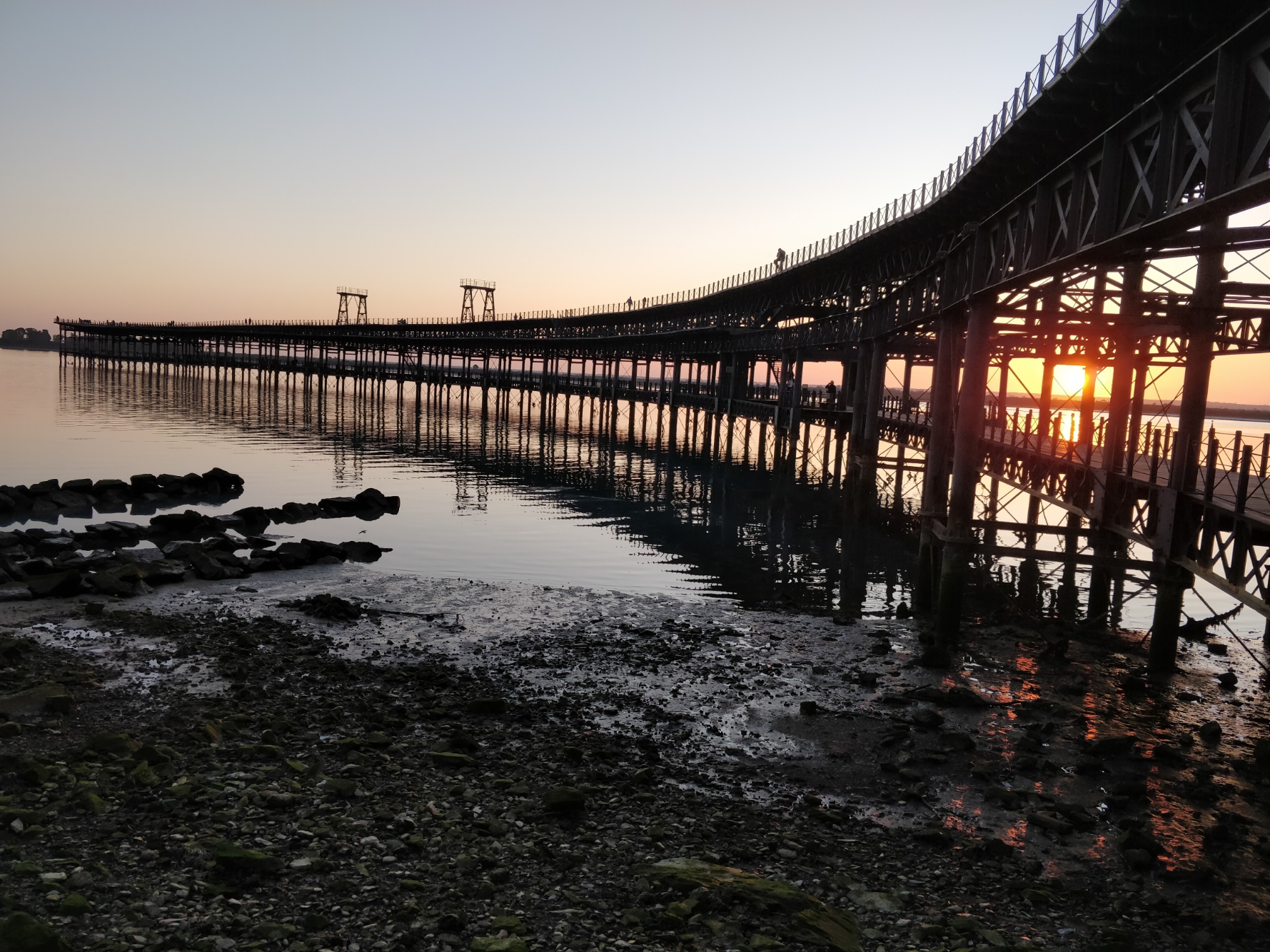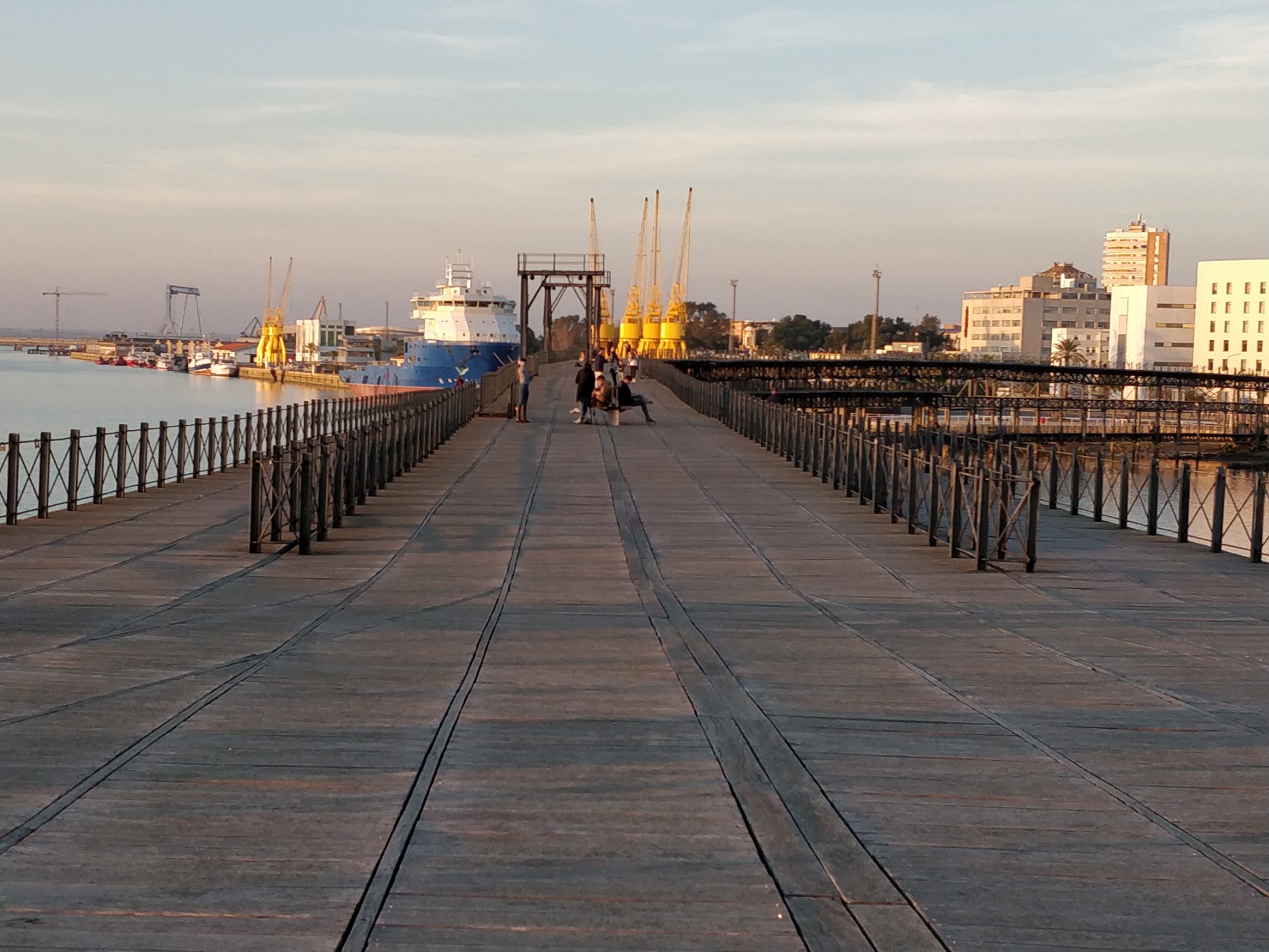Rio Tinto Pier (Huelva, Spain) on:
[Wikipedia]
[Google]
[Amazon]
The Rio Tinto Pier ( es, Muelle de Rio Tinto) was a commercial pier formerly used for the trade of material from the mines of the Rio Tinto Company in Andalusia, Spain. It is situated on the River Odiel in the city of Huelva. An estimated 150 million tons of ore were shipped from the pier over its life. Closed in 1975, it is now a popular tourist attraction and fishing spot. The pier is 1165 meters long, although part of that is built on reclaimed marshland.
 The railway wagons reached the ships at the end of the pier using gravity. This consisted of arranging different ways of entry and exit of wagons to and from the wharf. Those going on to the pier descended from the top of the beginning of the pier to the end of the jetty. Following a change of
The railway wagons reached the ships at the end of the pier using gravity. This consisted of arranging different ways of entry and exit of wagons to and from the wharf. Those going on to the pier descended from the top of the beginning of the pier to the end of the jetty. Following a change of

History
A site along the Rio Tinto had been mined since 3000 BCE. Over time, mining activities fell into neglect, until 1724 when the Spanish government began mining again. However, mining operations were inefficient, and the government itself was distracted by political and financial crises, leading it to sell the mines by auction in 1873.The syndicate purchasing the mine was led byMatheson and Company
Matheson & Company was a London-based trading house closely associated with Jardine Matheson of Hong Kong and Jardine Skinner of Calcutta. It arranged finance and handled imports from those two companies of products such as tea, silk and jute. ...
and, following purchase of the mine, the buyers launched the Rio Tinto Company. At the end of the 1880s, control of the firm passed to the Rothschild family
The Rothschild family ( , ) is a wealthy Ashkenazi Jewish family originally from Frankfurt that rose to prominence with Mayer Amschel Rothschild (1744–1812), a court factor to the German Landgraves of Hesse-Kassel in the Free City of F ...
, which greatly increased the scale of mining operations.
The company needed to get the ore produced at the mines to Britain, so in the two years after purchase an 83-mile railway was built, following the course of the Rio Tinto, with four tunnels and ten bridges. This connected with the company's own pier at Huelva. The construction of both the railway and the wharf required British expertise and British troops were used to protect the workers. The mine and the choice of Huelva as the port had a significant impact on Huelva, which went from being a small fishing village to the world's leading port for copper exports.
The pier was designed by the engineers, Sir George Barclay Bruce
Sir George Barclay Bruce (1 October 1821 – 25 August 1908) was a British civil engineer. He was primarily a railway engineer who worked for many railway companies in Britain, Europe, Asia and South America. He was closely involved with ...
and Thomas Gibson and was constructed between 1874 and 1876. Cast iron piles and columns were fabricated by Charles I'Anson, Son and Co of Darlington
Darlington is a market town in the Borough of Darlington, County Durham, England. The River Skerne flows through the town; it is a tributary of the River Tees. The Tees itself flows south of the town.
In the 19th century, Darlington underwen ...
, England and the Stockton Forge Co. from Stockton on Tees
Stockton-on-Tees, often simply referred to as Stockton, is a market town in the Borough of Stockton-on-Tees in County Durham, England. It is on the northern banks of the River Tees, part of the Teesside built-up area. The town had an estimated ...
. Both men already had considerable experience of railway and dock construction, including in Madras
Chennai (, ), formerly known as Madras ( the official name until 1996), is the capital city of Tamil Nadu, the southernmost Indian state. The largest city of the state in area and population, Chennai is located on the Coromandel Coast of th ...
in India. It had two platforms. Ore-bearing trains ran on the upper platform and general goods trains to import supplies for the mine ran on the lower platform. There are many structural elements, some of which were added at a later stage to repair and reinforce sections of the dock. A characteristic that distinguishes this pier from the others of its time is that its foundation is on wooden platforms at the bottom of the estuary.
The Rio Tinto pier began with an initial 238-meter section formed by an earth embankment built on concrete and brick. For the next 225 meters, still on reclaimed land, it is on a wooden viaduct. From this point it stands on double rows of four cast iron pillars (60 rows of four pillars). When entering the river, it continues for about 200 meters at right angles to the bank and then forms a broad curve with a radius of about 200 meters, culminating in a new straight section of about 170 meters oriented in the direction of the current and the tides. In total this iron section was 577.6 meters long, although in 1974 about 50 meters of it was destroyed to make way for road widening.
 The railway wagons reached the ships at the end of the pier using gravity. This consisted of arranging different ways of entry and exit of wagons to and from the wharf. Those going on to the pier descended from the top of the beginning of the pier to the end of the jetty. Following a change of
The railway wagons reached the ships at the end of the pier using gravity. This consisted of arranging different ways of entry and exit of wagons to and from the wharf. Those going on to the pier descended from the top of the beginning of the pier to the end of the jetty. Following a change of points
Point or points may refer to:
Places
* Point, Lewis, a peninsula in the Outer Hebrides, Scotland
* Point, Texas, a city in Rains County, Texas, United States
* Point, the NE tip and a ferry terminal of Lismore, Inner Hebrides, Scotland
* Point ...
, the wagons return via a line that was also descending. Therefore, the unloading of the trucks was done without any mechanical system.
Restoration
The pier remained in service until May 1975 when ships began to use a new facility in the nearby port of Huelva. Soon after that a section was removed to make way for widening of the road that goes along the river and the pier was effectively abandoned and fell into decline. In 1980 a contest was held for the reuse of the dock, but none of the ideas presented has ever been implemented. In 1990, initial repairs were finally carried out, with more detailed restoration following in 2006 with a budget of 14 million euros. At the start of the restoration the pier was lacking all of its wooden components.
References
*{{Commons category-inline, Muelle de mineral de la compañía Riotinto Huelva Mining in Spain Piers in Spain